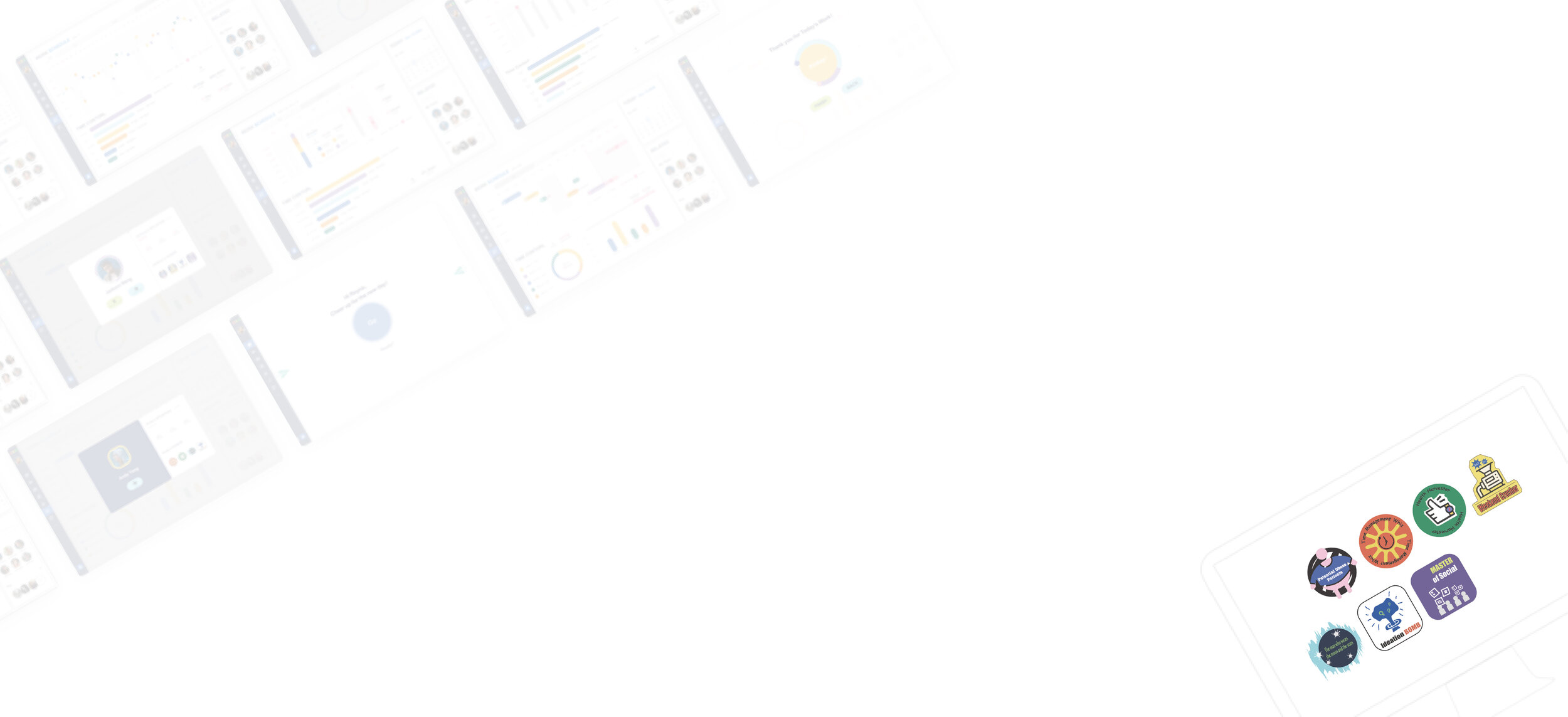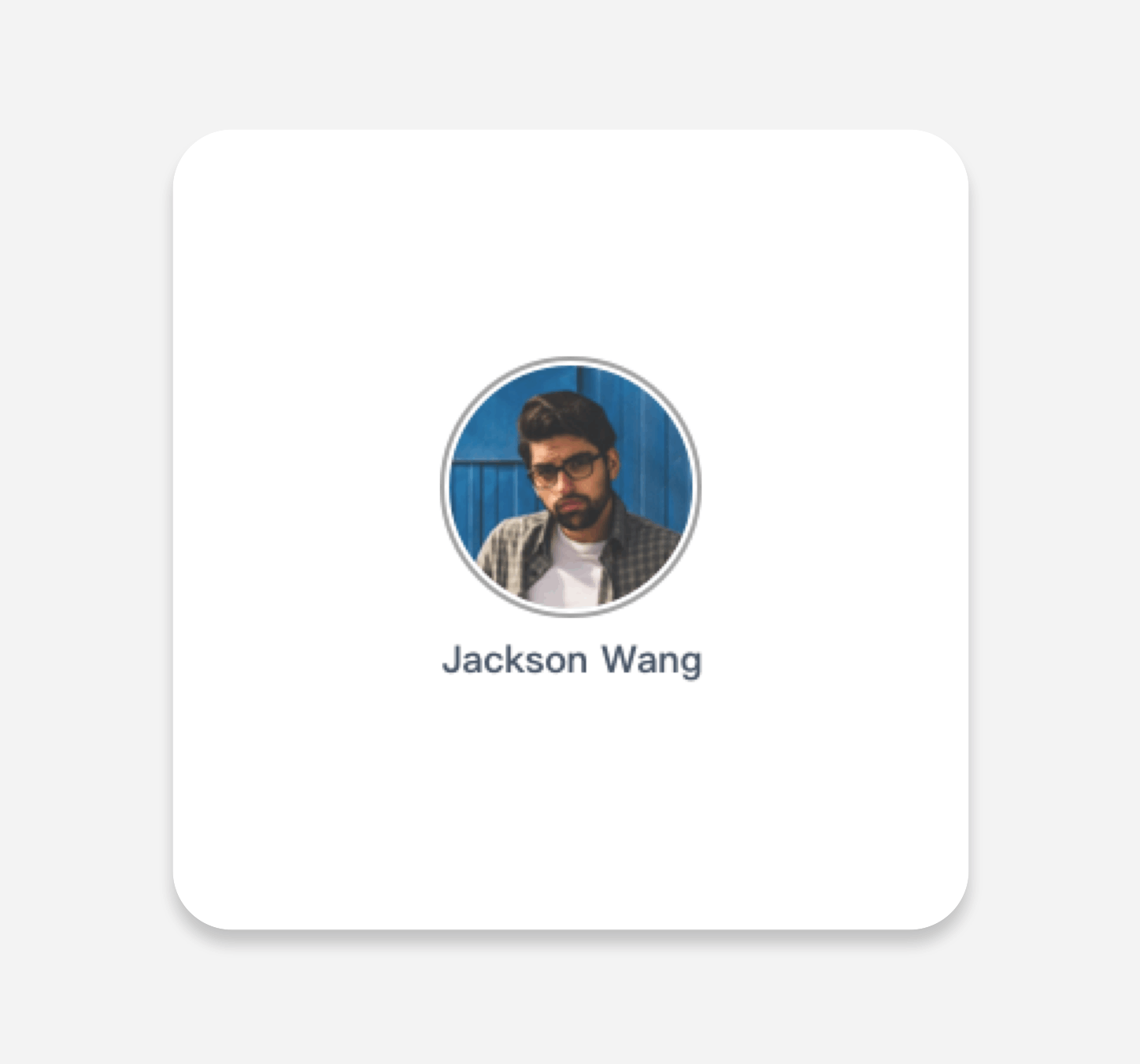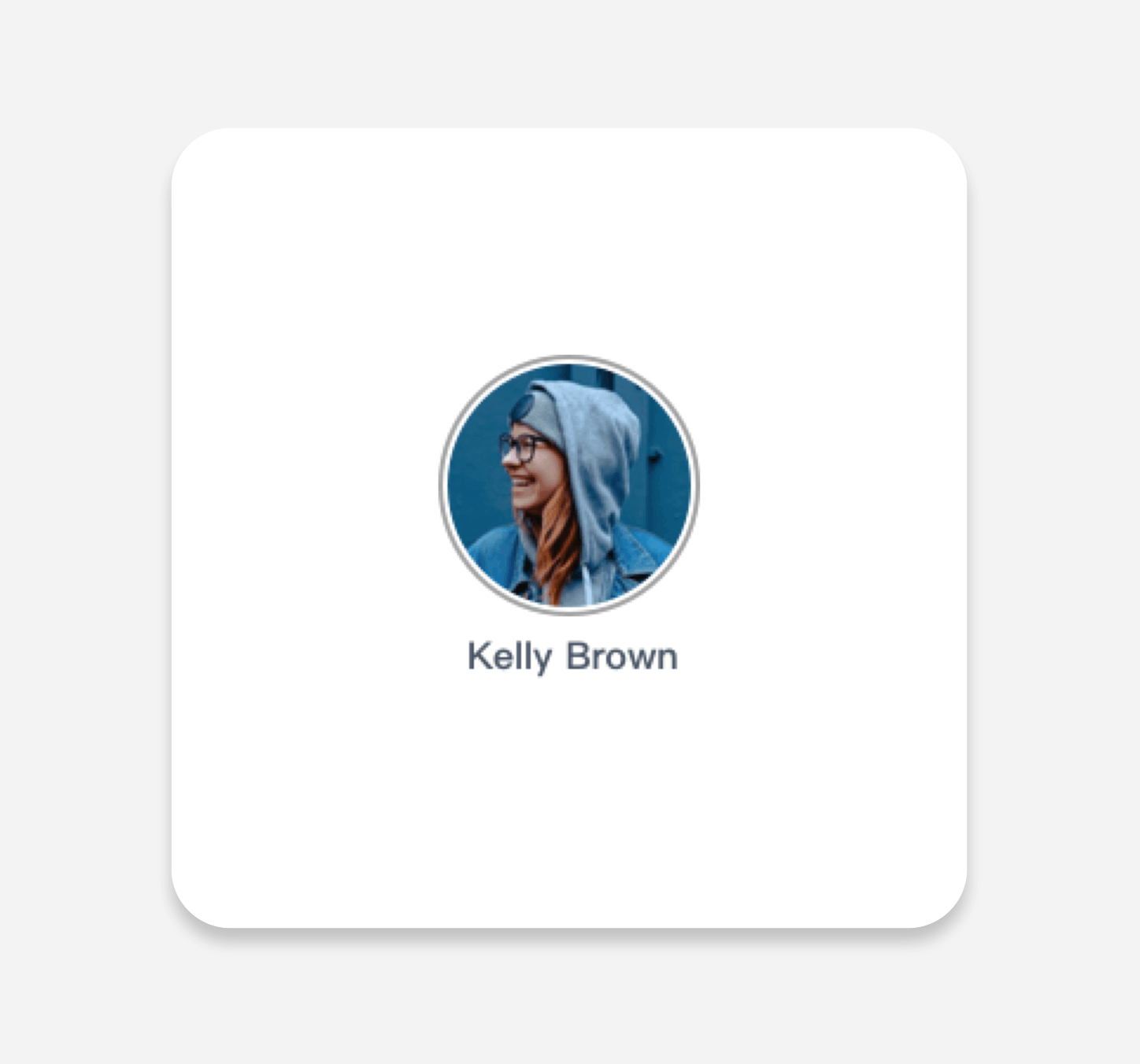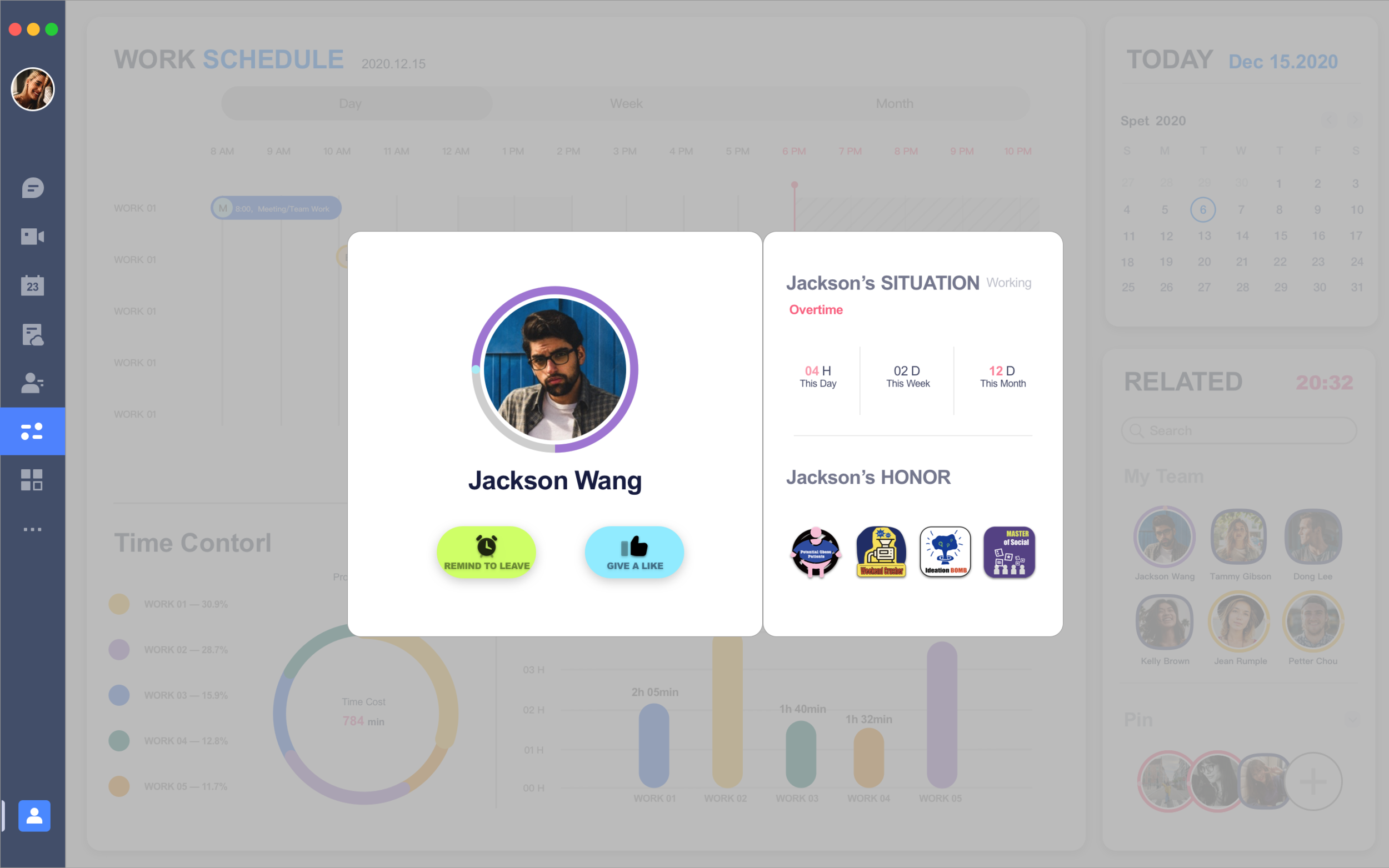
AN ADDITIONAL FUNCTION OF LARK
Time Space
Personal Project— 2 Months
Tool — Sketch, Principle,After Effects,Photoshop, InDesign
In the context of the global pandemic, more and more people are starting to work from home. While telecommuting offers convenience, it also blurs the line between work and life, causes problems in people's lives. Therefore, I had come up with some ideas about the telecommuting software, Lark, to help people work and live better.
The Conception of TimeSpace.
Timespace is an additional feature. It helps people mentally separate work and lifetime by the visualization of time flow, the ritual of commuting, the caring, the prodding of friends and colleagues, and some random surprises. It enables them to work from home and maintain a healthy life in a pandemic environment.
Project Process.
01- Background Investigation.
The biggest dissatisfaction with working from home is that the boundaries between work and life are becoming less and less clear. So after leaving the Internet, I invited four people who have been working from home recently for a group chat. Learn more about the causes and consequences of the problem of "blurring the line between work and life."
During the interview, interviewees often compare home office with the previous office mode, so I conducted secondary research:
The flexibility of telecommuting blurs the line between work and life.
In the case of reasonable work arrangements, the strict working time and off-duty scene transition of traditional office mode will give people psychological hints and make them adjust their state.
02-Problem Research.
Concerned Problems.
After investigation and data collection, in order to help Lark users better distinguish work and life in a single and unchanging home office environment, I put forward several main problems and solutions in the design:
Design Direction.
In this regard, four design directions are summarized
Ritual
Time Visualization
Social Contact
Gamification
03 - Ideation. & Concept.
Ideation.
According to the researched results and designed objectives, the concepts of time management are proposed:
Option1.
Time City & Land
Urban management: divide the functions of 24 pieces of land (24 h): 8 hours of work (office building), 8 hours of rest (urban green space), 8 hours of leisure (restaurant, gym, etc.). According to the daily working state, the construction of office buildings will occupy the land of other functions.
Option2.
Round Transformation
Conversion between working and off-duty time: The grey circle represents the rest period, the yellow circle represents the working time, and the remaining small circles are the categories of projects. The area of all the circles will change according to daily work.
Option3.
Time Locus
Records of users’ daily time trajectory and project categories display a visualization of working time and the periods of overtime are listed in red. According to the records, the weekly and monthly work trajectory charts are generated.
Concept Selection.
After the evaluation of three concepts, "Time Locus" is selected as the final design and solution strategy of the project.
Storyboard.
The selected concept and design directions are summarized into the storyboard which provides a better understanding of this project. The Speed Dating method will be used to validate the storyboard.
01. Ritual
Speed Dating Result: EFFECTIVE
According to the test, the sense of ritual can effectively help them to change their mental state. The change of mental state can also lead to behavior change. The start of work mode reminds them to focus on their work better, and the reminder after work will let them finish their work as soon as possible and pay attention to the time.
02. Time Visualization
Speed Dating Result: EFFECTIVE
Time trajectory visualization has great help to users. Testers respond that time trajectory can let them clearly know the working state of the day, what time period they are doing, how long each project takes, whether they waste time, etc. They can adjust and allocate their work according to the time trajectory, so as to complete the task more efficiently and distinguish the time of life and work.
03. Social Contact
Speed Dating Result: EFFECTIVE
According to the response of the tester, fast and simple social ways can shorten the distance between themselves and related personnel more quickly. Due to working from home and the social distance, this way of communication is necessary. Most of the time, you don't have to waste time talking to see the working status of the relevant personnel, so you can carry out effective care. Friends urge and remind each other, also help to complete the work efficiently.
04. Gamification
Speed Dating Result: EFFECTIVE
According to the response of the tester, Badges and honors drop regularly to give users a sense of surprise and experience. At the same time, let the user know their recent work status in a more interesting way. External stimuli are more likely to stimulate their autonomy than direct reminders of their health and time.
Final Choice.
According to the test results of storyboard, “WORK SCHEDULE”,“RELATED”,“MY HONOUR” and “COMMUTING RITUALS”, these four functions will be planned and arranged in the whole page and software use process.
04-Prototyping. & Testing.
The project prototype generated from the concept needs to be tested and modified step by step through the Low-fi prototype, Mid-fi prototype, and High-fi prototype.
Low-fi Testing.
The first edition
Work schedule Low-fi & Feedback
Off work situation & Feedback
Visual representation of the ritual & Feedback
Commuting shift
The low-fidelity model was tested by three people, and the performance of the four functions was adjusted based on the test feedback. Adjustments include:
Performance of time: the specific time of each day should be shown to help users see their time flow more specifically.
The entire page should show a specific date so that users can choose to view the history.
The visual representation of overtime hours should emphasize the concept of encroachment.
With Lark's existing chat feature, the chat is not necessary for this page.
In the weekly schedule, users also need to see the details of their daily work.
For the sake of privacy, others cannot see the specific work content and working hours of users.
The modified part
Work schedule - Modified Low-fi
Working state - Modified Low-fi
After the testing results and the iteration of the Low-fi prototype, the Mid-fi model has been given more thought in terms of layout and typography.
Mid-fi Testing.
Work Schedule & Social
Work Schedule-Mid-fi
Ritual
Ritual-Mid-fi
Testing & Modify
After the Mid-fi test, some modifications were made.
Modify the mid-fi model
Change 01 - Divide up your break time and work time into distinct zones.
Change 02 - Go a step further and explain the allocation of work time.
Change 03 - Add workflow for months.
High-fi Testing.
After the low-fi and mid-fi prototype tests were completed, the scheme was further developed visually, and the final high-fi prototype results were tested and modified.
05-Final Design.
After investigation, thinking, design, testing and other processes, the final design was obtained.
Time Schedule.
Visualization of time locus can help users understand their working status and help them establish better working habits.
01. Daily Schedule
With the visualization of the daily work, users can know exactly where their hours are, what they're working on, and what they're working overtime for.
Users will be reminded of their work during overtime hours. At the same time, users can see the total time and content ratio of their daily work.
Normal-Day-Work Schedule
Overtime-Day-Work Schedule
02. Week Schedule
Users can see their overtime days and hours in a week, as well as the total time spent on various tasks in the whole week. Summing up the working hours of the surrounding units can make users better understand their recent working status and make better work plans.
Normal-Week-Work Schedule
When users have doubts about their work of a certain day, they can choose to view the day's work.
Overwork-Week-Work Schedule
03. Month Schedule
Users can see their work trends for the month, the number of overtime days worked and the total number of overtime hours worked. At the same time, the system will distinguish between weekdays and weekends. Life-time invaded by overtime will be reminded in red. The length of each project for the entire month is also visible to the user.
Normal-Month-Work Schedule
The projects with the longest hours per day are shown in the monthly work schedule. Users can view each day separately or for the entire month. Long-term working time records can help users to have a clear understanding of their working habits and develop good working habits.
Overwork-Month-Work Schedule
Social.
The social board is divided into two sections, one consisting of team members from work, and the other consisting of friends you care about. Users can see their status during off-hours. Working Overtime or Leaving Work.
Commuting Shifts and Reminders
Work overtime status
Off work status
Related status area
01. Overtime and Care
For people who work overtime, users can see the project they are working on (the color rotates around the avatar to represent the project), the last time they worked overtime, the number of days they worked, and the achievements they achieved. You can give your partner a thumb up or remind him to finish work as soon as possible.
02. Off Duty and Care
For people who are off duty, the user can see that they are in a state of rest. Remind people to try not to interrupt their time with too much work. You can also reward them for their productivity or good work schedules.
Ritual.
Compared with the commuting process of the traditional working model, working from home also needs a certain sense of ritual to help users transition from one mental state to another. Work more efficiently and enjoy life better.
01. Start to Work
At the beginning of the work time, users are encouraged to help them quickly switch to work from the psychological state.
02. Off Duty
Users can set a reminder time to leave work. The system will celebrate the end of a day's work, help users adjust their mental state from time to time, and remind users not to keep working and forget the time.
For the users who still need to back work, the system will remind them according to their recent working status.
Gamification
A gamified reward system can increase the user's sense of experience and achievement on a visual and psychological level. It allows users to get a greater share of the mood in more mental cycles and helps them connect with society, others, work and themselves while working from home.
01. Reverse Stimulus Badge
The reverse stimulus.
Users who receive this type of badge need to be aware of their work schedules and workloads. Users need to arrange their time reasonably, develop good working habits, pay attention to health, and balance their work and life.
02. Health Badge
Positive stimulus.
Users who receive these badges have a good recent work schedule, high productivity, and a good work-life balance. It encourages users to stay that way.
03. Job Type Badge
These badges are related to the user's recent work experience. It gives the user a better idea of the type of work being done recently. Helping users to be aware of work problems and situations.
Write at the end
Although intelligence can provide a lot of convenience for human life, it should not become an obstacle for people to enjoy life, and let electronic products uncontrolled invasion of people's life. Especially in the context of COVID-19, when people suffer from the dual threat of mental health and physical health, the development of era and technology and should help people better balance their lives and manage their health.





